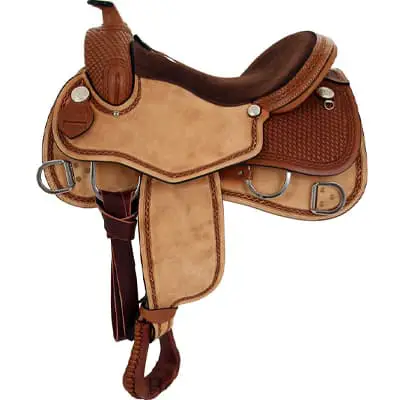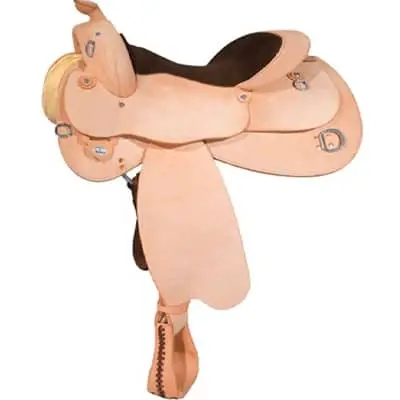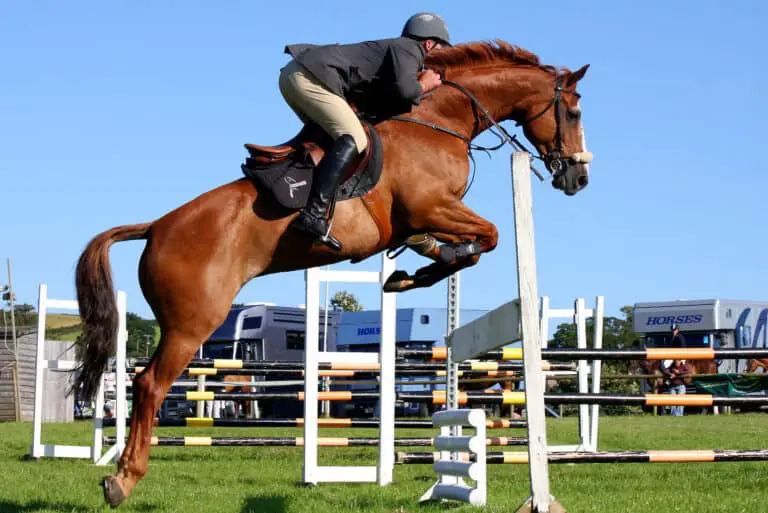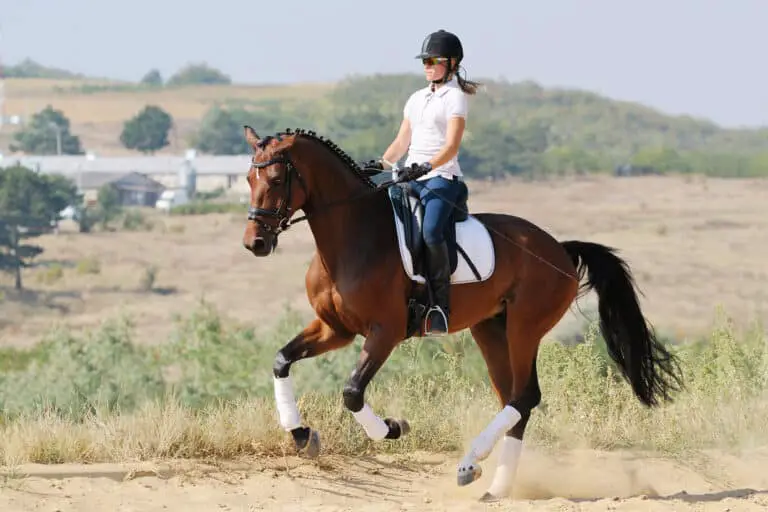10 Best Training Saddles Actually Worth the Money (2024)
Western riding professionals use training saddles for working young or green horses because the structure and setup of the saddle give them flexibility.
The best training saddles have a flat and padded seat that allows the rider to move – similar to a reining saddle – and D rings for attaching a martingale or other equipment.
We Recommend
Best Training Saddles
1. Billy Cook Training Saddle

We love this Billy Cook, it’s the best training saddle. It consistently ranks as one of the best sellers, and for a good reason.
The name Billy Cook is synonymous with the highest quality western saddles, and his training saddle is used by professionals everywhere for its great fit, durability, long lifespan, and comfort.
Riders that spend two to three hours at a time in this saddle have no fit complaints for either them or their horse.
The build and padding in the seat, as well as close contact with the horse, allow an effective and efficient ride, without getting worn out or saddle sore. It does take time to break this saddle in though.
What We Liked
- Tree size and gullet width fit most Quarter and stock horses
- Low horn and cantle provide greater flexibility of movement in the saddle
- Roughout creates more grip in the saddle, helping the trainer
- Front and back D-rings on both sides of the saddle
- High-quality and durability coming from the Billy Cook brand
What Can Be Improved
- You’ll need to ride in this saddle for a while to break it in
- Only designed to fit Quarter Horses or those with a similar build
- Limited seat sizes available with only three choices
Type: Training
Weight: 36 lbs
Seat Size: 15.5’’ to 17’’
Gullet With: Quarter Horse gullet
2. Bates Outback Heritage CAIR Saddle

The Bates Outback Heritage CAIR Saddle is the best English training saddle, although the argument can be made that it’s an Australian stock saddle too.
The Bates system has an easy-change gullet system, allowing you to customize the fit with six different sizes. One of the big advantages compared to a western training saddle is how lightweight this saddle is at about 19 pounds.
This saddle is best for those who need a lighter-weight saddle and will also be trail riding, working on the ranch, or like the feel of closer contact with the horse. As with all English saddles, the stirrup leathers and irons are an additional purchase and cost.
What We Liked
- The seat is sculpted to support the rider for long hours in the system
- The Y-girth system is adjustable based on the horse and terrain
- Technologically advanced stock saddle for fit and comfort
- Comes in either black or Havana brown colors
- Customized saddle fit with six different gullet sizes in the easy-change system
What Can Be Improved
- Stirrup leathers and irons are sold separately
- Technically, it’s an English training saddle, and purists may not want you to use it
- Be careful to select the right seat size, it differs in English saddles
Type: English Saddle in Australian style
Weight: 18.7 lbs
Seat Size: 15’’ to 16.5’’
Gullet With: 8.3’’ to 10’’
3. South Bend Saddle Company Training Saddle 2387

The South Bend Saddle Company consistently crafts quality products, and this lightweight training saddle is popular with professionals and amateurs alike. This model has the added advantage of being designed for those hard-to-fit, horses with short backs, making it a must-have in any professional tack room.
The four color options available and hand tooling in the leather make it just flashy enough to pass at a show if needed. It comes standard with D-rings and a low cantle and horn for greater movement as you’re working horses. There are only three seat sizes available, but most professionals are in this range.
What We Liked
- This is a lighter-weight saddle at only 31 pounds
- Great for training, with the roughout providing extra grip
- Perfect for horses with a shorter back
- Hand-tooled leather adds some style and flash not found in other training saddles
- Four color options; you’ll spend a lot of time looking at it, might as well like the look
What Can Be Improved
- Doesn’t fit horses with a long back – it’s meant for short-backed horses
- There are only three seat sizes available
- Little customization in tree size available – only a regular or wide tree
Type: Training Saddle
Weight: 31 lbs
Seat Size: 15’’ to 17’’
Gullet With: 6.5’’ to 8’’
4. American Saddlery AJ Trainer Saddle

The American Saddlery AJ Trainer Saddle is a budget-friendly option that doesn’t sacrifice comfort or usability. This trainer saddle is ready to do the dirty work, keeping your reining or show saddle ready for the better days. Whether it’s riding on a rainy day, working a young horse, or practicing maneuvers, this saddle has you covered.
The standard wrong-side-out leather seen on so many models is on this saddle too, with a four-inch cantle offering added security in the deep seat pocket. The close-contact skirt makes it easy to cue the horse. Unfortunately, seat and gullet sizes are limited on this saddle.
What We Liked
- This is the best budget training saddle that we’ve found
- Designed to fit Quarter and stock horses best
- The double rigging is reinforced for durability through the years and rides
- The four-inch cantle offers extra security in the seat pocket
- Roughout on the fenders provides some extra grip for rambunctious rides
What Can Be Improved
- Limited to a 7-inch gullet size on a fiberglass-covered wood tree
- One of the heavier training saddles on the market at 40 pounds
- The only seat size option is a 16” or a 17” seat
Type: Training Saddle
Weight: 40 lbs
Seat Size: 16’’ to 17’’
Gullet With: 7’’
5. Circle Y Roughout Training Saddle

The Circle Y Roughout is a good training saddle from a well-respected brand, boasting the same structure as their show saddles, in a model you won’t mind working hard in all weather. The swell and horn make this saddle useful for roping training, among other disciplines.
The roughout on the fenders and suede seat provide a little extra grip for those long days in the saddle, and the lighter weight of this model, and ample skirt, help spread the weight evenly on the horse’s back. This saddle is more expensive than some other training saddles, but that’s because of the quality and durability.
What We Liked
- It has the same seat and tree as the show-quality Circle Y saddles
- A suede seat is both comfortable and adds some extra grip
- The pelican-style horn on the saddle helps keep a rope low
- One of the lighter-weight western training saddles
- The 13-inch swell can support reining if that’s desired by the trainer
What Can Be Improved
- The only color available is a light tan that will show any scuffs or dings
- The long, 28-inch skirt won’t work with short-backed horses
- More expensive than some other training saddles
Type: Training Saddle
Weight: 31 lbs
Seat Size: 14.5’’ to 17’’
Gullet With: 6.5’’ to 8’’
6. High Oak Training Saddle The Oakland

High Oak’s Oakland is a full roughout training saddle that professionals rely on for prepping for the show ring or starting young horses. The roughout provides extra grip and makes cleaning easy because there’s no intricate tooling to work around. The range of seat sizes, and higher cantle, along with the roughout make this the best training saddle for beginners too.
One downfall of this saddle is that the D-rings are smaller than on other brands, however there are more of them, allowing more customization of training aids. This may be the best training saddle for the money that we’ve found because of this combination of features.
What We Liked
- A range of seat sizes from a 13” up to a 17” are available
- Extra D-rings on the saddle offer more flexibility than other brands
- Cleaning this saddle is easy because the entire saddle is roughout
- Tall cantle for extra security in the saddle
- Lightweight for a western saddle at only 28 pounds
What Can Be Improved
- Light color won’t hide any damage, wear, and tear
- D-rings are smaller than they are on other training saddles
- The wide tree is only available in the 16” or 17” version
Type: Training Saddle
Weight: 28 lbs
Seat Size: 13’’ to 17’’
Gullet With: 6.5’’ to 8’’
7. Wintec Pro Stock with Swinging Fender HART

This Wintec Pro Stock with Swinging Fender HART is great for saddle training because it incorporates several features – it’s lightweight, synthetic, easy to clean, has an adjustable gullet, is comfortable, and the stirrup leathers are under the fender. Riders can easily spend a day riding in this saddle, and then hose it off at the end of the day to clean it up.
Fit is adjustable so it can be used on multiple horses, and the panels are soft, conforming to the muscles of the horse, and causing them a painless ride too. The Wintec Pro Stock lacks some of the security of a traditional stock saddle but is still a great option.
What We Liked
- The soft panels mold themselves to fit the horse being worked
- The billets can easily be changed to customize the saddle
- Changeable gullets allow flexibility of fit, extending the lifetime use of the saddle
- The seat is grippy and comfortable and supports the rider at any speed
- It’s easy to clean the sweat and grime off a synthetic saddle
What Can Be Improved
- Wintec saddles are synthetic and not made of leather
- Lacks the security and deep seat of traditional western saddles
- Horses that get used to this lightweight saddle may struggle switching to western tack
Type: English Saddle
Weight: 17 lbs
Seat Size: 14.5’’ to 16.5’’
Gullet With: 8.3’’ to 10’’
8. Big Horn Training Reiner

The Big Horn Training Reiner is another quality training saddle for those in the reining discipline. Scope is limited to a distinct population on this bare bones saddle; it’s only available in a 16-inch seat with Quarter Horse bars. But, if you are working on a training circle or other reining moves, this is the saddle you want.
It features a roughout seat, wide stirrup tread, and large, reinforced D-rings, all designed to assist the reining rider in preparing for the show ring. The off-brown color is unique and not one seen in many other saddles but doesn’t diminish the functionality at all.
What We Liked
- Extra-large and reinforced D-rings on this saddle
- The seat is roughout to provide extra grip and traction
- The stirrups are 4.5 inches wide for extra tread width and stability
- Designed with reiners in mind – and a great saddle to prep for the show in
- Steele EquiFit Classic tree is known for its quality and consistency
What Can Be Improved
- Only available in a 16” seat
- The Big Horn is a bare bones saddle and is true to that – there’s nothing extra
- Quarter Horse bars mean it’s a hard fit for other breeds
Type: Training Saddle
Weight: 31 lbs
Seat Size: 16’’
Gullet With: Medium plus and 5.5” high
9. Dakota Training Saddle

Equitation riders need an impeccable turnout in the ring, and a good ride, both of which are accomplished through plenty of practice. The Dakota Training Saddle is the best saddle for training in the equitation discipline, keeping the show saddle pristine, and it can be used in other disciplines too.
It has an equitation seat and lacks the bulky rigging that most other western saddles have, and covered stirrup leathers to prevent rubbing. Unfortunately, those needing a 17-inch seat need to pay a bit extra with this saddle. The Quarter Horse bars mean it fits most equitation horses well, and riders will be comfortable during long practice rides.
What We Liked
- Horn is the pelican-style that’s popular in roping disciplines
- Doesn’t have any bulky rigging under your legs while riding
- Riders find this to be the most comfortable training saddle
- Stirrup leathers are covered with leather for extra protection
- The tree has Quarter Horse bars in an Equitation style with a 5-year warranty
What Can Be Improved
- Designed for use as an equitation saddle, although it can be used in other disciplines
- Only aluminum stirrups are currently available from Dakota
- There’s an additional cost for the 17” seat
Type: Training Saddle
Weight: 26 lbs
Seat Size: 15’’ to 17’’
Gullet With: 6.5’’ to 8’’
10. South Bend Saddle Company Training Saddle 2300

Many think the South Bend Saddle Company makes the best western training saddle, and the 2300 reinforces that impression. The company has a good product and made several versions so that everyone can get the training saddle they need, while also fitting it to themselves and their horse. This is a durable and comfortable saddle built to withstand stress and pressure that the professional can use for many years.
The suede seat and padding are great on a long ride, but their downfall is inclement weather. They hold the moisture and the heat, making riding outdoors in these conditions a bit more challenging.
What We Liked
- All the benefits of the 2387, except in a model made for horses with longer backs
- The tree is fiberglass reinforced wood that can withstand stress
- The heavier weight makes this an ideal stallion training saddle
- Suede seat provides traction and security
- Double dee rigging is durable and able to withstand pressure
What Can Be Improved
- The suede seat takes a while to dry if out in the rain or snow
- Takes time to break the saddle in
- Extra padding in the seat retains heat in warmer weather
Type: Training Saddle
Weight: 37 lbs
Seat Size: 15’’ to 17’’
Gullet With: 6.5’’ to 8’’
How to Choose a Training Saddle?
Saddle fit for the rider and the horses is most important. Proper fit is the foundation for comfort and will eliminate misbehavior due to pain.
Grip
Training often involves young horses, and sometimes they make quick and sudden movements. If this happens, a little extra grip can go a long way. That’s why most training saddles have roughout or a suede seat. Both provide extra grip and traction for the rider. Roughout can be a better choice for inclement weather and staying cooler.
Close Contact
Western saddles aren’t usually known for their close contact, but this is one feature you should seek in a training saddle. The closer contact is achieved through less rigging and helps the rider practice and train with more precise cues. Once the horse fully understands the cues, the close contact isn’t as imperative.
Low Pommel
The pommel’s purpose is to support the rider, and a high pommel is needed in some western disciplines. However, in a training saddle, a low pommel is better because it allows the rider more freedom of movement that’s often necessary during training. Look for saddles with a lower pommel and swell unless you have a specific need.
Extra Hardware
Training sometimes involves martingales or other aids you don’t use in the show ring. The extra hardware, specifically D-rings, on a training saddle make adding these in a snap. Often, training saddles are used out on the trail too, and the D-rings are useful in this setting for packs or other materials as well.
Comfort
Fit may be the most important factor to consider, but that doesn’t mean you should sacrifice comfort. Most training rides are a whole lot longer than a class at a show or a reining pattern. Choose a saddle that you’ll be comfortable in for hours on end. Key factors are the seat size and shape, padding, and stirrup placement.






